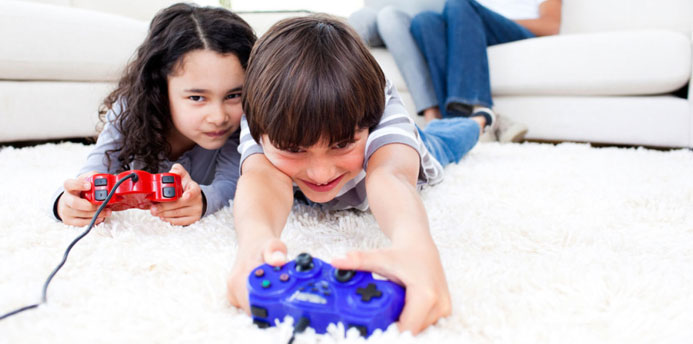Summer’s here and it’s a perfect day. But instead of racing outside to enjoy the sunshine, your kid is glued to a video game.
What’s a parent to do? And how much screen time is too much?
According to Scott Rigby, Ph.D., research psychologist and co-author of “Glued to Games: How Video Games Draw Us In and Hold Us Spellbound,” there are no set rules to how much gaming is too much for kids. However, he does offer some things to think about.
Out of balance
First, he asks parents to consider if games are “crowding out,” in other words, are they sucking up a considerable portion of your child’s time to the extent that it detracts from other activities? Rigby also advises parents to look for signs that your child’s life seems generally “out of balance,” and “lop-sided” toward games. Indicators for this include a lack of enthusiasm for spending time with friends or doing non-gaming activities.
4 Hours is the tipping point
As for how many hours constitutes “too much,” Rigby says, “In our data, when players reported playing four or more hours daily (on average), we have seen this associated with less satisfaction and well-being in their lives. But when gaming has become a half-time job for your child (or more), it is worth a close look.”
When asked if there is a secret to minimizing screen time in favor or outdoor or other activities, Rigby offers these suggestions for how to draw your child away from gaming without starting a war.
How to set limits
First, he says, kids will feel less controlled and angry if parents acknowledge their desire to play video games, so start the conversation about limit-setting by emphasizing that you understand how fun and exciting the games are.
After that, parents should think in terms of how you might create interesting opportunities outside of games, rather than “controlling” and “limiting” gameplay itself. “Sports, hobbies, activities with friends and family – all of these can be engaging and satisfying if they are made available to kids.” Rigby says. “By creating such new opportunities as an alternative, you more naturally and meaningfully encourage a balance to video game play.”
Steve Bennett and his wife, Ruth, have recently written a book “101 Offline Activities You Can Do With Your Child.” Steve suggests that one way to get kids to engage in activities other than video games is to bring them into the conversation about what to do.
“Ask which activities they’d like to try, and stress that you’ll be participating, too” he says. “Make it a fun challenge, such as ‘Hey, let’s see if you can come with a cool scoring system for this activity.’ Or, do the activity with your spouse or other adult in the household-your kids will naturally want to play, too.”
Still stymied for ideas? Here are two activities, courtesy of the Bennetts:
Kitchen Bowling. It can be played indoors or outside on a smooth surface. Set up paper cups (or toilet paper tubes) and roll a foam or rubber ball at the “pins.” Encourage creative scoring and rules (like the object is to NOT knock over the red cup).
Oversize Checkers. This game entails using paper plates as checkers and squares of paper to create the board. There’s something about the giant pieces and board that makes for giant fun.

